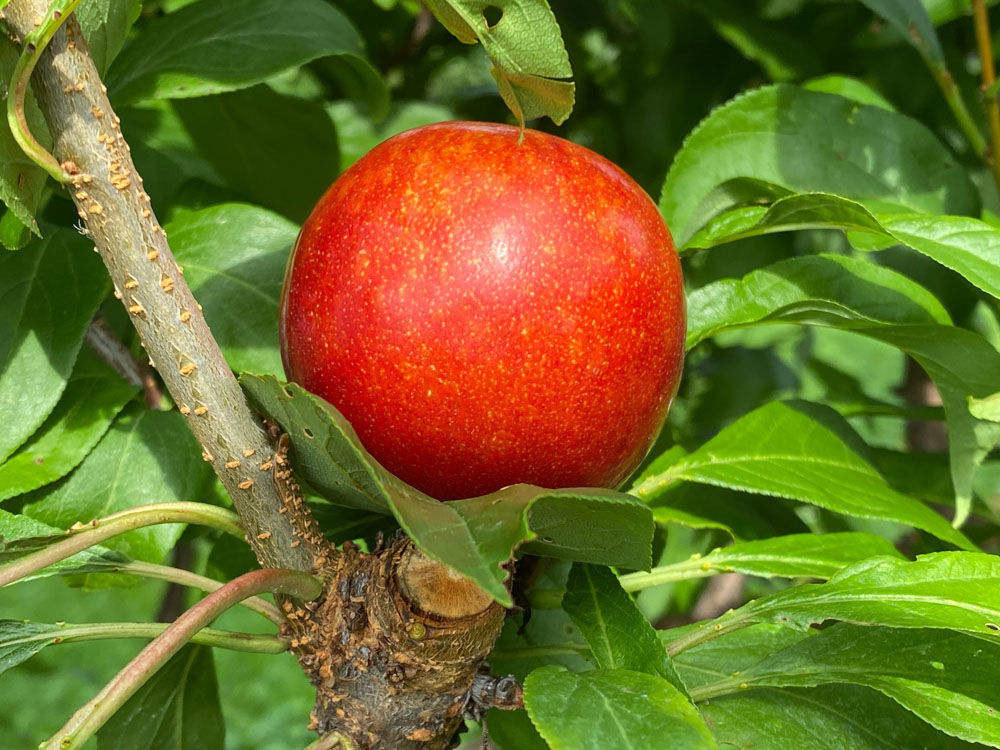An attractive, highly disease-resistant apple, ideal for organic growers.
Santa Rosa Plum on Krymsk 1 (Spring 2025)
You are viewing a tree that will ship in Spring 2025. You can also find trees for Spring 2024.
A reliable, self-fertile plum that performs very well on the West Coast.
The tree is vigorous, upright, compact, and highly productive. It is reliably prolific and performs especially well on the West Coast. This is an excellent choice for a cold-hardy, easy-to-grow plum. It is self-fertile, but it should be grown with another midseason Japanese plum for optimal fruit quality. Suitable partners include Burbank, Shiro, Satsuma, and Elephant Heart. It is an excellent pollenizer, considered by many growers to be a "universal pollenizer" for Japanese and hybrid plums. Santa Rosa is quite susceptible to bacterial spot but somewhat resistant to black knot.
Santa Rosa produces a medium-sized, round plum with a purplish-red skin that is speckled with tiny pale dots. Yellow around the pit, the juicy flesh is a luscious, deep red near the skin. The flavor is rich, aromatic, and delicious. It ripens in early August, about a month before Stanley.
Long considered the industry standard for plum flavor, Santa Rosa was bred by Luther Burbank of Santa Rosa, California and introduced in 1906. From UC Davis: "‘Santa Rosa’ was described as “‘a complex hybrid containing a mixture of Prunus triflora [salicina], P. Simonii, and P. americana, with the salicina characters predominating.’ The exact cultivars will never be known, but the red flesh would indicate that the ‘Satsuma’ played a part” (Howard, 1945). However, Boonprakob and Byrne (2003) found that ‘Santa Rosa’ did not have P. americana in its parentage, but did have P. cerasifera." This heritage makes Santa Rosa comparable to Russian hybrids such as Lavina and Obilinaya. Santa Rosa was Luther Burbank's most successful and celebrated introduction. It remains one of the most commonly cultivated plums in America, southern Europe, North Africa, South Africa, Australia, and New Zealand.
The Fruit
Fruit Type
Category: Plum
Subcategory:
Japanese, Hybrid
Fruit Uses & Storage
Uses: fresh eating, jam, baking, canning, freezing, jelly
Storage duration: less than one month (approximate, depending on storage conditions)
Fruit Appearance
Skin color: red
Flesh color: red
Fruit Origins
Parentage: unknown
Origin: Santa Rosa, California
Introduced in: 1906
Introduced by: Luther Burbank
The Environment
Calendar & Geography
USDA zones: 5 - 8
Chill hours: 700
Ripening date: Aug 02 (approximate, in New York State) 30 days before Stanley
Tree Height & Spacing
glossary
Rootstock: Krymsk 1 Rootstock
Rootstock size class: Semi-Dwarf (40% of Standard)
Tree spacing: See details
Good for wildlife planting? N
Diseases & Pests
glossary
Bacterial Spot: Very Susceptible
Black Knot: Resistant
Pollination
Pollination Factors
glossary
Bloom group:
Is it self-fertile? Y
Is it fertile? Y
Ploidy: Diploid
Rootstock size class:
Semi-Dwarf (40% of Standard)
Pollination Partners
This table shows the first few results from a full search for pollenizers of Santa Rosa Plum on Krymsk 1. Please see our Pollenizer Search to run other queries and read how the application uses various factors. Also read more about fruit tree pollination.
See all pollination matches for Santa Rosa Plum on Krymsk 1
Featured Products
A few things we're loving right now...
A full-flavored, freestone white peach.
A traditional semisharp cider apple from Spain.
A widely-grown, large, yellow-fleshed nectarine.


















